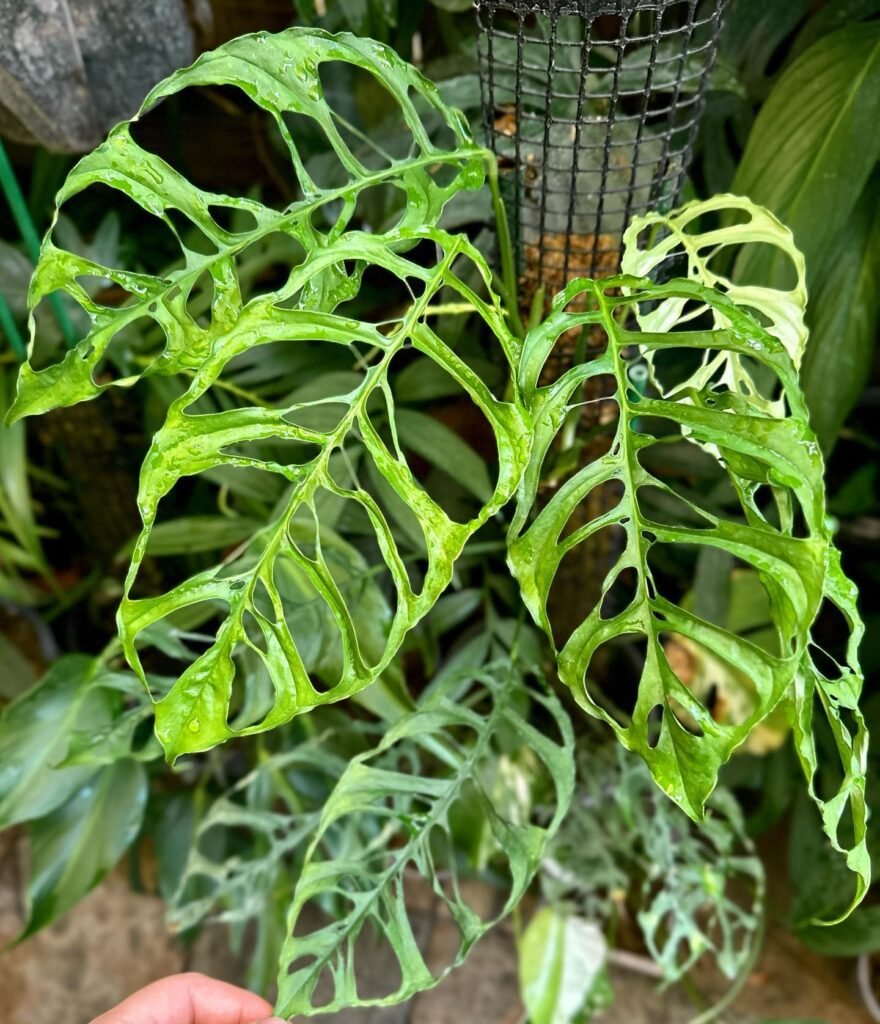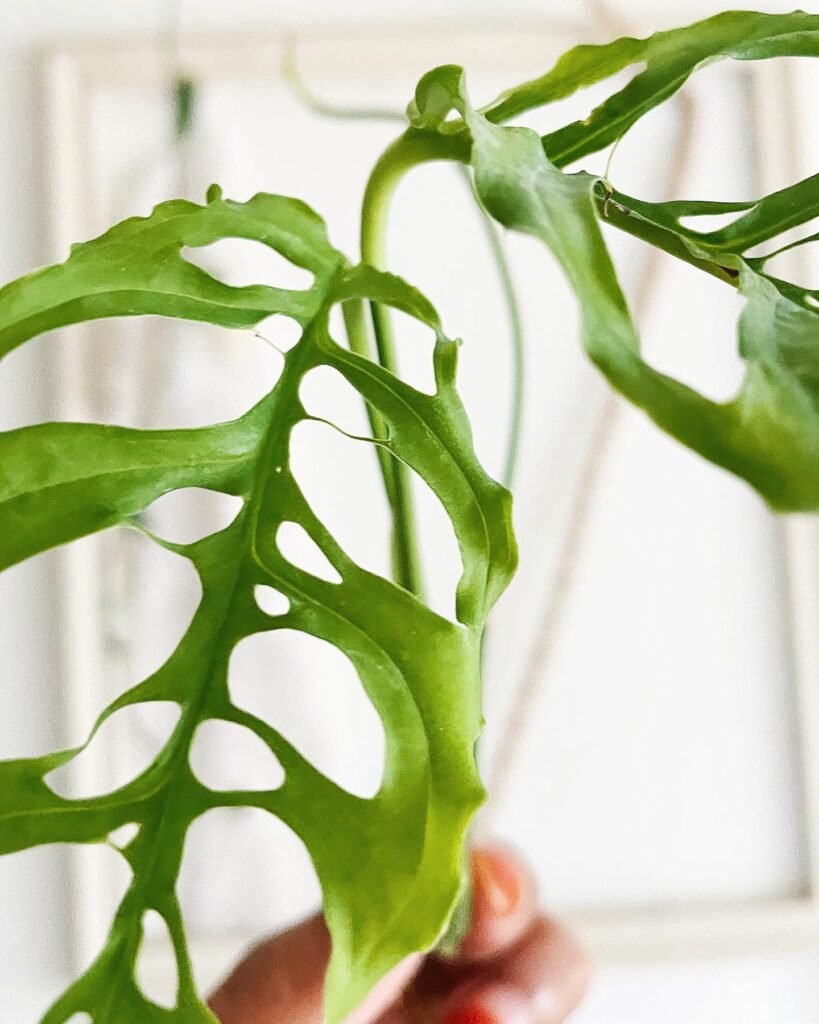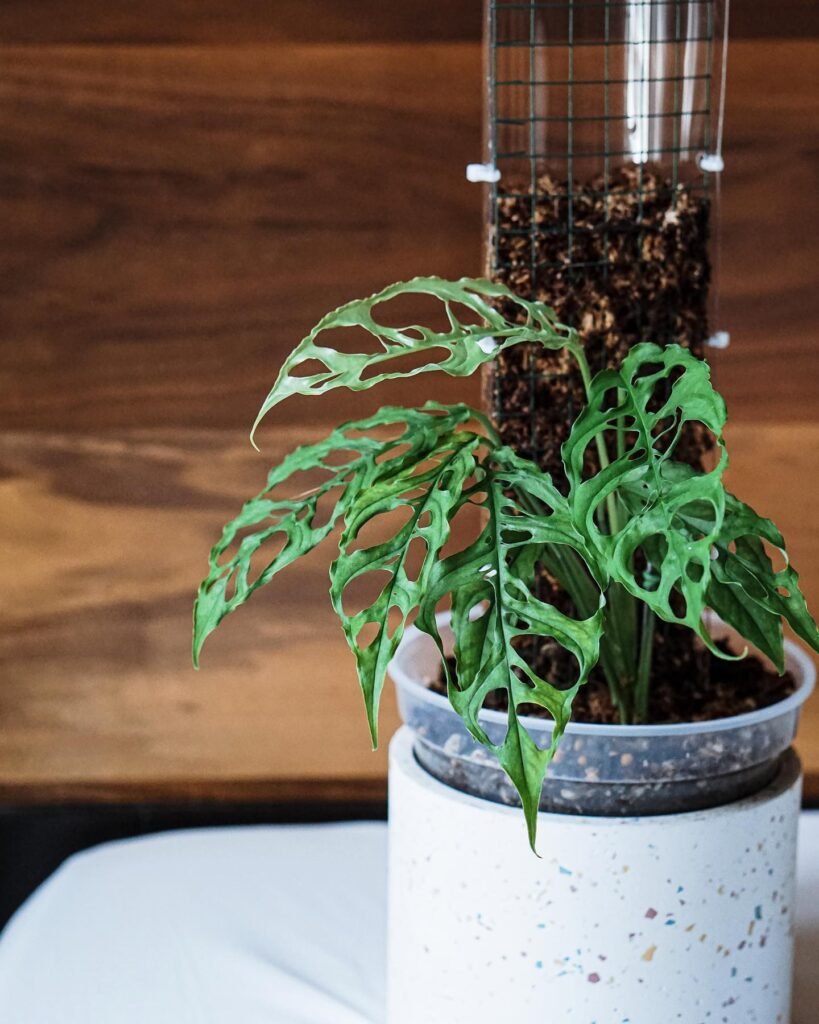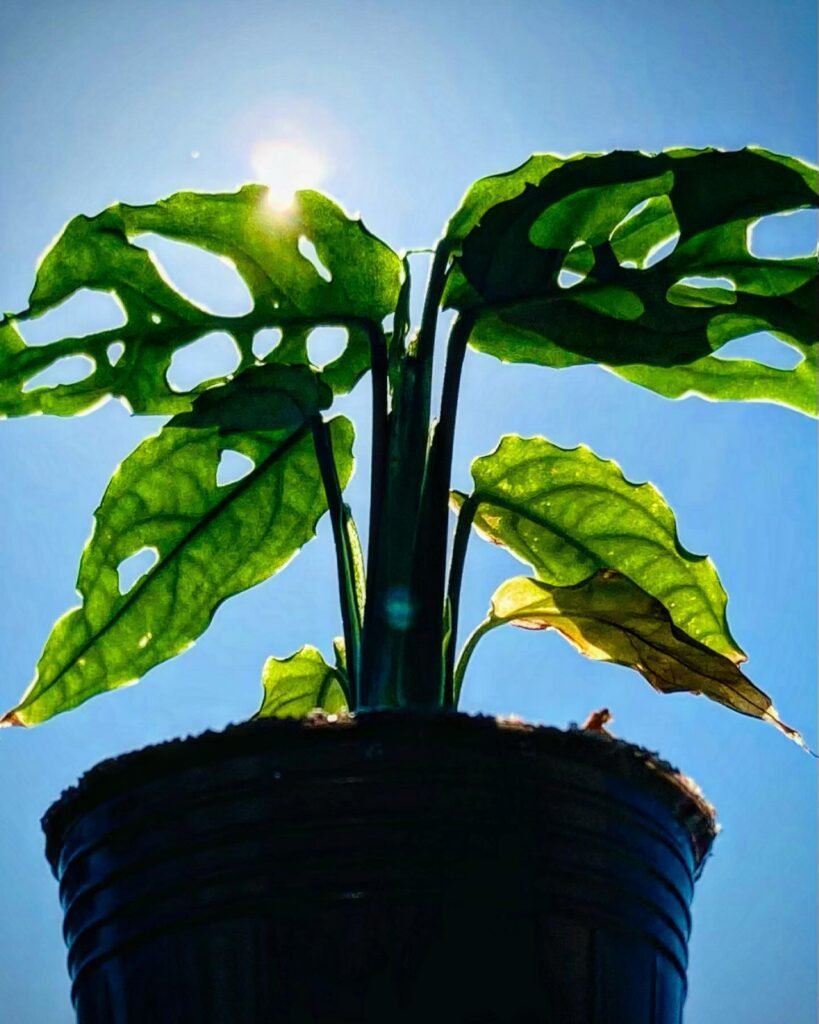Step into the leafy realm of the Monstera Obliqua, an elusive cousin of the more familiar Monstera Albo. This rare gem, known for its lace-like leaves, is a whisper of elegance that’s capturing the hearts of houseplant aficionados across the UK. Unlike its robust relative, the Obliqua’s delicate foliage is a living tapestry of green, thriving in the dappled light of its tropical home.
Appearance of Monstera Obliqua


Monstera Obliqua is a plant of subtle grandeur, belonging to the vast Monstera family known for its decorative flair. This particular species, native to the tropical forests of Central and South America, is a horticultural jewel, capturing the imagination of enthusiasts with its perforated leaves. Here’s a snapshot of its identity and how it stands apart from its family members:
- Origins: Hailing from the dense undergrowth of the rainforest, where light filters through the canopy above.
- Leaves: Notable for the extravagant fenestrations; each leaf is a natural work of art with more air than leaf.
- Flowering: Rarely seen in cultivation, its blooms follow the typical Monstera pattern but are a sight less commonly beheld than its leafy splendor.
- Family: Part of the Araceae family, sharing kinship with the likes of the famed Monstera Deliciosa but holding its own with distinct finesse.
Each type of Monstera Obliqua, whether it’s ‘Peru‘, ‘Expilata‘, or ‘Bolivia‘, shows off its own special beauty through its leaf shapes and patterns. This plant stands out not just for how it looks but also for the little details that make it different from other Monsteras. The Monstera Obliqua is more than just a houseplant; it’s like a piece of natural art, bringing a bit of the jungle’s mystery into your home with each leaf.
 Did you know the Monstera Obliqua has super holey leaves not just for looks? Those holes help it deal with strong winds in the wild. It’s like nature’s way of making sure the leaves don’t get torn up by letting the wind pass right through. Pretty smart, huh?
Did you know the Monstera Obliqua has super holey leaves not just for looks? Those holes help it deal with strong winds in the wild. It’s like nature’s way of making sure the leaves don’t get torn up by letting the wind pass right through. Pretty smart, huh?
Light Requirements for Monstera Obliqua


Monstera Obliqua thrives in specific light conditions, crucial for its well-being:
- Bright Indirect Light: Place it in an area that gets plenty of light, but avoid direct sunlight which can damage the leaves.
- Filtered Sunlight: If possible, provide filtered or dappled sunlight, resembling its natural rainforest habitat.
- Avoid Dark Corners: Low light areas can hinder its growth, so keep it away from dark, shaded corners.
By ensuring your Monstera Obliqua receives the right amount and type of light, you’ll help it maintain its distinctive appearance and promote healthy growth.

Watering Tips for Monstera Obliqua


Watering your Monstera Obliqua properly is key to keeping this delicate beauty thriving. This plant prefers a balance in soil moisture, similar to its natural rainforest environment. Here’s how to get it just right:
- Check Soil Moisture: Before watering, touch the soil. If the top inch feels dry, it’s time to water.
- Water Thoroughly: Give your plant a good drink, allowing water to reach deep into the roots, then let any excess water drain.
- Reduce in Winter: During the cooler months, when the plant isn’t growing much, it needs less water.
Following these watering tips will help ensure your Monstera Obliqua stays healthy, mimicking the natural rhythm of rainfall it would experience in the wild.

Fertilizing and Soil for Monstera Obliqua


For your Monstera Obliqua, getting the soil and fertilization right is like setting the stage for a thriving, healthy plant. Here’s a deeper look at what it needs:
- Soil: This tropical beauty flourishes in a soil mix that drains well yet holds some moisture. Think of the rainforest floor – it’s moist but not waterlogged.
- Fertilizing: It’s a bit like feeding; just enough but not too much. During the growing months of spring and summer, a monthly dose of a half-strength, balanced fertilizer does wonders.
Here’s a quick table for easy reference:
| Aspect | Details |
|---|---|
| Soil | Well-draining mix (peat, pine bark, perlite) |
| Fertilizer | Balanced, half-strength, monthly in growing season |
With the right soil and a gentle touch with the fertilizer, your Monstera Obliqua will not just grow; it will thrive. Imagine creating a little piece of the rainforest right in your home, where every leaf unfurls with health and vitality.

Pruning and Maintenance for Monstera Obliqua


Pruning and maintenance are key to keeping your Monstera Obliqua in great shape. This unique plant doesn’t require much, but a little care goes a long way. Here’s how you can keep it looking its best:
- Pruning: Trim away any yellow or damaged leaves to keep the plant healthy. This also encourages new growth.
- Dusting Leaves: Gently wipe the leaves with a soft, damp cloth to keep them dust-free and shiny.
- Support: Monstera Obliqua is a climber, so consider providing a moss pole or trellis for support as it grows.
- Check for Pests: Regularly inspect for common houseplant pests and treat them promptly.
Regular pruning and maintenance not only keep your plant healthy but also enhance its natural beauty. Imagine each leaf as a piece of art that you’re helping to preserve and display in all its glory.

Propagating Monstera Obliqua


Propagating Monstera Obliqua is a rewarding way to expand your collection or share this rare plant with friends:
- Stem Cuttings: Choose a healthy stem with at least one node and a few leaves. The node is where roots will sprout.
- Rooting Medium: You can root the cutting in water, sphagnum moss, or a soil mix. Ensure the node is submerged or buried.
- Indirect Light: Place your cutting in bright, indirect light, away from direct sunlight.
- Patience is Key: Roots take time to develop, especially for a slow-growing plant like Monstera Obliqua.
Propagating this plant is like capturing a piece of its natural beauty and allowing it to grow anew. Watching a new plant emerge from a cutting can be a truly magical experience.

Repotting Tips for Monstera Obliqua
Repotting Monstera Obliqua is an important aspect of its care routine, allowing it to continue growing healthily. Here’s a guide to make repotting smooth and stress-free:
- When to Repot: Monstera Obliqua typically needs repotting every two years. Look for signs like roots growing through the drainage holes or the plant becoming top-heavy.
- Choosing a Pot: Pick a pot that’s slightly larger than the current one, with good drainage. This gives the roots more room to grow.
- Soil Mix: Use a well-draining potting mix. A blend of peat, pine bark, and perlite is ideal, as it retains moisture but allows excess water to drain.
- The Repotting Process: Gently remove the plant from its current pot, loosen the roots if they’re compacted, and place it in the new pot with fresh soil.
Repotting can be a fresh start for your Monstera Obliqua, giving it the space and nutrients it needs to flourish. Picture it like giving your plant a new, larger home where it can stretch out and grow even more beautifully.
 Monstera Obliqua, often confused with Monstera adansonii, is famed for its extremely fenestrated leaves, more so than any other Monstera. This rare plant is a true gem in the plant world, with some leaves being more hole than leaf, creating a delicate lace-like appearance that’s both striking and highly sought after by collectors.
Monstera Obliqua, often confused with Monstera adansonii, is famed for its extremely fenestrated leaves, more so than any other Monstera. This rare plant is a true gem in the plant world, with some leaves being more hole than leaf, creating a delicate lace-like appearance that’s both striking and highly sought after by collectors.
Helpful Videos about Monstera Obliqua
Diving into the world of Monstera Obliqua can be even more enjoyable with some visual guidance. Check out these carefully selected videos for a comprehensive look at caring for this rare and stunning plant.
- Behind the Hype: Monstera Obliqua Review – 1 Year Journey
- Monstera Adansonii vs Obliqua : Differences and an In-Depth Comparison
Frequently Asked Questions about Monstera Obliqua

Looking after Monstera Obliqua and curious about how to do it best? We’ve put together this FAQ section to help you out. It’s packed with easy-to-follow answers for all the big questions about caring for this stunning plant. Whether you’re just starting or looking to get better at gardening, this guide is for you.
It’s a rare Monstera variety known for its highly fenestrated leaves.
It prefers bright, indirect sunlight. Avoid direct sun which can scorch its leaves.
Water when the top inch of soil feels dry. Be careful not to overwater.
Use a well-draining potting mix, ideally with peat, pine bark, and perlite.
Fertilize lightly every month during the growing season with a balanced fertilizer.
Trim away any yellow or damaged leaves to keep the plant healthy.
Propagate using stem cuttings with at least one node, in water or soil.
Every 2-3 years, or when it outgrows its pot.
Yes, it’s well-suited for indoor growth with adequate light and humidity.
Watch for common pests like spider mites and mealybugs.
Yes, it can be toxic if ingested, especially to pets and children.
Look for extremely thin, delicate leaves with more holes than leaf material.
This could be due to overwatering or insufficient light.
It’s a slow grower, especially compared to other Monsteras.
Obliqua has much more fenestration and thinner leaves than Adansonii.
We hope this FAQ helps you in your Monstera Obliqua journey. If you have more questions or need additional guidance, feel free to drop them in the comments. Let’s grow together in this fascinating world of rare Monsteras!

